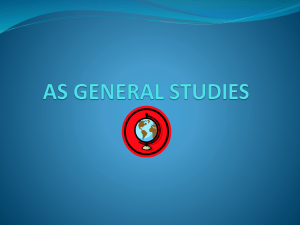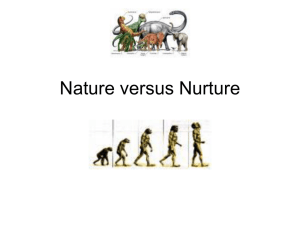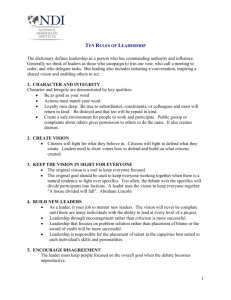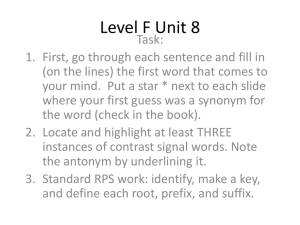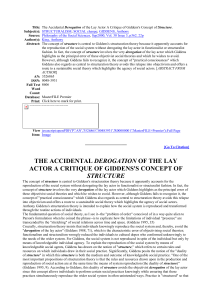What is structure and agency? How does this framework help us in
advertisement
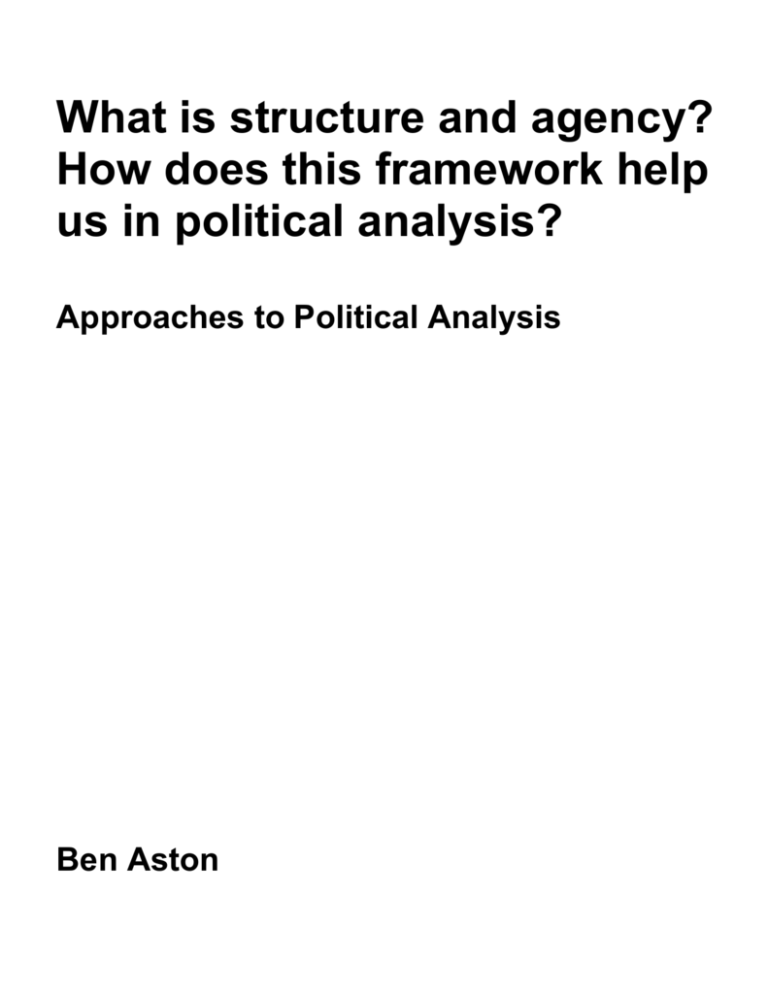
What is structure and agency? How does this framework help us in political analysis? Approaches to Political Analysis Ben Aston What is structure and agency? How does this framework help us in political analysis? For it is part and parcel of daily experience to feel both free and enchained, capable of shaping our own future and yet confronted by towering, seemingly impersonal constraints. Consequently in facing up to the problem of structure and agency social theorists are not just addressing crucial technical problems in the study of society, they are also confronting the most pressing social problem of the human condition.’1 Structure and agency is a key understanding mechanism within social science. The approach attempts to answer the question of action; how is it that I can do what I want with others when their goals are different, and often incompatible with mine? Prominent social scientists including Giddens and Archer have suggested that the ‘Structure-Agency’ question is the most important theoretical issue within the human sciences. This debate has been slower to make an impact on political science than on some other social science disciplines yet it has been argued that structure-agency questions should be recognised as central to the way we study politics. It can be argued that there is no ‘escape’ from issues of structure-agency. Hay argues: “Every time we construct, however tentatively, a notion of social, political or economic causality we appeal, whether explicitly or (more likely) implicitly, to ideas about structure and agency.”2 The structure and agency can be regarded as crucial to an understanding of Social Sciences; it has at its base a fundamental question which humans have posed for a long time. This is an essentially normative question; are we free to act as we please, or are we shaped and governed by structures? Nobody would argue that structure controls us completely, but neither, in the post-modern world, are we completely free. It is prudent to first determine examine what we can understand by the terms ‘structure’ and ‘agency’. This paper will begin will deal with some definitions and summarise the position from both sides of the agency structure debate. By examining the case of the recent second Gulf War in Iraq, 1 2 M. Archer, Culture and Agency: the place of culture in social theory, Cambridge University Press, revised edition 1996, p.xii. C. Hay, ‘Structure and Agency’, in D. Marsh & G. Stoker (eds), Theory and Methods in Political Science, Macmillan, 1995, p.189. Ben Aston 2 an analysis of the usefulness of the framework will be discussed to ascertain its validity in political analysis. The 'agency approach' is sometimes twinned with methodological individualism, which argues that the only reality we can grasp is the deeds/actions of individuals, not classes. The approach suggests structural forces such as hegemony cannot be seen as real; they are intangible and thus we can say nothing provable about them. This implies an epistemology that we cannot look at classes to explain the behaviour of individuals. It is therefore quite a severe approach to the human sciences. Giddens suggests the actor is an embodied unit and as such, a possessor of causal powers that she may choose to employ to intervene (or not) into the ongoing sequence of events in the world. This makes her an agent. Giddens “…define[s] action or agency as the stream of actual or contemplated causal interventions of corporeal beings in the ongoing process of events-in-theworld.”3 It is analytical to the concept of agency that a person or agent “could have acted otherwise.”4 This conception of the agent ties agency to power. Agency approaches see the individual as atomized, positting a voluntarist approach to human action. They argue that the context in which an individual lives is a pluralism; social power is spread between groups, and that no single group dominates. The way to analyse, therefore, is by looking at what the individual tells us - there is an onus on reflexivity; on the individual being able to account for and be aware of the reasons and implications of their actions. This approach also pays attention to time. History is taken to be the outcome of freely chosen choices and self-determined deeds: the "great man" view of history which sees Napoleon, Hitler, Mussolini, Margaret Thatcher and Bush as figures that, through freewill and behaviour, changed the course of history. Extreme versions of this thinking hold that explanation of this is beyond human understanding. Critics of this approach claim that this is metaphysical although structure approaches give us a very one-dimensional view. Individualists would argue that we are richer as human beings than structure approach theories can predict. This is an overview of agency approaches, which are often lumped 3 4 Giddens, A. 1976. New rules of sociological method. London: Hutchinson. p.75 Ibid. Ben Aston 3 together with conservatism, claiming that there is freedom and that we succeed or fail by our own qualities and actions. Structure is essentially explanation in terms of the social/economic/political context in which action occurs. Structuralists deny that the human actor is the ultimate social reality, focussing instead on the situated human actor. Key concepts in this focus are emplacement and embodiment. A structure approach is often associated with the political left and theorists such as Smith and Marx. It argues that because conditions change through time and space then the "great man" theory doesn't work. Structuralist approaches recognise that there are specific conditions which produce human actions or behaviour. Essentially individuals are believed not to be atomised but acting as a result and through the constraints and structures in which they exist. Behaviour is then not a result of free will but a product of structural factors. In positing reasons for behaviour, you are beginning a structure approach: explaining action according to the structure/context in which it takes place. A structure approach would hold that individuals are situated actors in place and embodiment. We are embodied physically, defining out health, opportunities, life possibilities, etc., and emplaced in terms of lifestyle, conditions, etc. Our actions therefore respond to the structures of one kind or another, in which we are situated. Another way of thinking about how structure changes us comes from the 19th century social scientist, Durkheim. An example comes from Durkheim's work on suicide, which listed three categories in which suicide could occur: Egoistic: for reasons of self-dissatisfaction or in response to personal emotion. Altruistic: for the good of other people Anomic: because all structures have broken down and life no longer has meaning This shows that even in relation to this extreme decision, the individual does not act without reasons – reasons are taken in response to structures. Durkheim's theory of 'social facts' clarifies the relationship between structure and infrastructure. Structures have priority, externality and constrain, in relation to our behaviour. Structuralists reject pluralism: they argue that the atomized actor is the only actor we can know. We can therefore predict life chances according to structures such as class, race and gender. Ben Aston 4 From a structuralist approach we can understand the relevance of the debate to politics. Structuralist Marxists would argue that human action and choice is determined by class. Society is composed of superstructure, what we can call civil society which includes things such as education, the arts and culture and substructure which is constituted of the material and economic base. Marx argued that the substructure defines the superstructure – clearly a structuralist and deterministic view of society and culture. Both levels, according to Marx, are controlled by a ruling class. Men make their own history, but not under circumstances of their own choosing. Marcuse, for example, argues that we do not live in a free society, but a one-dimensional one. There is no freedom, simply reproduction of the views of the ruling class. Similarly, structuralist feminism, of the 1960s, held patriarchy as the key structural influence. The work of Germaine Greer and Kate Millet reflects this. They saw the systematic exclusion and subordination of women from many aspects of the economy and society, and explained the position and behaviour of women through the structures set up by men. There are criticisms of this approach. Firstly, structuralist accounts underestimate the reflexivity and autonomy of human actions. They tend to concentrate on the individual's position in a hierarchy, and do not deal with the ambiguity and ambivalence of human experience. There is a skewed reality at work: they attribute too much power/influence to few structures. Marxists, for example, have been accused by feminists of ignoring gender as a structure. Furthermore, they postulate repetitive patterns of behaviour and therefore cannot explain how changes, for example Glasnost and the abandonment of Communism have occurred. Loyal and Barnes elucidate the key differences between structure and agency. They suggest “agency stands for ‘the freedom of the contingently acting subject over and against the constraints that are thought to derive from enduring social structures. To the extent that human beings have agency, they may act independently of and in opposition to structural constraints, and/or may (re)constitute social structures through their freely chosen actions. To the extent that they lack agency, human beings are conceived of as automata, following the dictates of social structures and Ben Aston 5 exercising no choice in what they do. That, at any rate, is the commonest way of contrasting agency and structure in the context of what has become known as the structure/agency debate.”5 No current theorists would argue that either agency or structure are completely in control of our behaviour, although much is still influenced by this debate: most people today hold the view that agency and structure are enmeshed together. It is still a debate which informs how we think and research. A consequence of the abandonment of extreme positions is the new prevalence of postmodern thought, for which structure is no longer the complete answer. Stuart Hall, for example, admitted in the 1980s that we are living in new times, not defined by class, as in the Marxist approach of his work. Feminists have also accepted that patriarchy is not the sole reason for women's behaviour. Postmodernism has filled the vacuum. Postmodernism reflects the ambiguity and ambivalence of life, and suggests that structures such as class are discursive, representations of how life occurs, not real life. This is a thread in the work of Baudrillard, Barthes, Foucault and Derrida. Derrida's work, for example, foregrounds the play of meaning in his 'differance' which implies 'defer' and 'differ'. The point is that meaning is always deferred: there is never a final truth or fact, and reality is always being rewritten. This radically destabilises the idea of a shared reality, emphasising the elasticity of human experience and the need to look at life 'processually'. Everything is moving, unfixed, unfastened, and there are no underlying fixed structures. Postmodernism also emphasises the need to be tolerant of other people's viewpoints. It encourages multiculturalism. Another strand is Hybridity theory, which claims that everything is hybrid in some sense: that there is no purity. Consequently, no language or point of view is superior. “Giddens in the form of what he calls ‘Structuration’ theory has set out to try and transcend the dualism of structure and agency. His basic argument is that, rather than representing different phenomena, they are mutually dependent and internally related.” 6 Structure only exists through agency and agents have ‘rules and resources’ between them which will facilitate or constrain their 5 S. Loyal & B. Barnes “Agency” as a Red Herring in Social Theory, Philosophy of the Social Sciences (SAGE Publications), 2001: 31: 4 p.507-524 S. McAnulla, The Structure-Agency Debate and its Historiographical Utility, University of Birmingham ‘The Utility of Structure, Agency and Discourse as Analytical Concepts’ 6 Ben Aston 6 actions. These actions, can lead, in turn, to the reconstitution of the structure, defined as rules and resources, which will, in turn, affect future action. Thus, we have a close interrelationship between structure and agency. Giddens’ metaphor for this is that rather than being distinct phenomena structure and agency are in fact two sides of the same coin. As such, we have a conception of the mutual constitution of structure and agency. As Taylor argues, “…this conception is the most distinctive feature of ‘Structuration’ theory, yet a feature which serves crucially to undermine the theory as a whole.”7 This approach combines the best of agency and structure approaches - the actor is situated, but not clueless. This emphasises reflexivity, and assumes a high degree of selfawareness on the part of the actor, but also allows for the influence of structures and awareness of emplacement. Structuration theory is Giddens' attempt to bridge the "gap" between theories which place emphasis on either structure or agency at the expense of the other. Structuralism represents one extreme on a continuum of theory in which social structures such as class, gender or race are seen as systems which are so pervasive through time and space that people have little or no choice but to operate within them. At the other end of the continuum, there is an emphasis is on the subjective individual, structures are seen as ephemeral; they are relative and secondary to agency. These extremes can be characterized as "systems without actors" in the case of the former, and "actors without systems" in the case of the latter. Giddens' explains the relation between theses two extremes by offering a 'theory of structuration' that: “…provide[s] an account of human agency which recognizes that human beings are purposive actors, who virtually all the time know what they are doing (under some description) and why. At the same time [as understanding that]...the actions of each individual are embedded in social contexts 'stretching away' from his or her activities and which causally influence their nature.” 8 Grasping the recursive nature of social practices - the duality of structure – is according to Giddens, the key to achieving this. The study of politics largely concerns conceptions of power; ‘who gets what, when and how.’ 9 We can understand the role of the state to include controlling and distributing limited resources which M.Taylor, ‘Structure, Culture, and Action in The Explanation of Social Change, in W.J.Booth et al (eds), Politics and Rationality, Cambridge University Press, 1993, p.124. 8 Giddens, Anthony (1984) The Constitution of Society: Outline of the Theory of Structuration. Cambridge, UK: Polity Press. p.258 9 Lasswell, Harold D. 1936, Politics: Who Gets What, When, How, New York 7 Ben Aston 7 determines who benefits, and is included, and who does not benefit and is excluded. Structure and agency can assign responsibility for political actions; it is the head of state or the political-economic environment that causes events and change? An acknowledgement of the structure agency debate allows us to acknowledge the influence of structures and agents in the political world. The structure agency debate cannot be seen as an approach to political analysis in the same way that rational choice theory might be. However, it is an important way of considering and analysing issues. Let us examine for example, the cause of the Second Gulf War in Iraq. Structure and agency debates will examine this with the approach of; were the actors involved free to make decisions independently of structures and so, as individuals, change the course of history? Or was it a situation in which structure was the predominant factor and the actions of the individuals involved was pre-ordained? From an agency perspective, there are clearly two actors who made key decisions which led to the conflict; George Bush and Saddam Hussein. We can understand that George Bush may have been inclined to go to war as he was simply following in his father’s footsteps, attempting to finish off his father’s unfinished business and trying to consolidate American hegemony. Similarly, we can see that Saddam Hussein was responsible for the conflict by his continued refusal to allow weapons inspectors to sites and his recalcitrance to convince the world that they were not harbouring terrorism and producing weapons of mass destruction. On the structure side of the debate we can see that there were factors of structure; Bush and Hussein were individuals acting in accordance with the structures they themselves may have been unaware of, so that these actors were situated in an environment which meant the course of action was inevitable. Some structural factors that could be considered would be; rising oil prices which, had they continued would have undoubtedly fuelled the recession and increased US domestic stability. Furthermore, instability in the region and the history of Iraqi development of banned weapons and expelled weapons inspectors meant that in a structural sense, there was a sense of inevitability of the conflict. The issue of hegemony could also be regarded as a structuralist consideration as it pervades both economy and culture; it is the field on which the game is played. In providing an explanatory framework for political analysis, postmodernism is largely defunct. Postmodernist accounts of structure and agency reduce it to a discourse in which structure and Ben Aston 8 agency are no more than arbitrary discursive constructs. In the case of war in Iraq we can see that this is a gross oversimplification. However, we can clearly see that these phenomena – Saddam, Bush, oil, terrorism and political stability are very much ‘out there’ with their own characteristics and properties. Structure and agency can produce social effect without being articulated in discourse. Furthermore, Giddens’ rejection of the dualism of structure and agency, regarding it as two sides of the same, replies to the criticism of dualistic constructs. The dialectical approach, and in particular, Giddens’ structuration theory provides a plausible explanation which, as Giddens elucidates, the two sides of the same coin. In the case aforementioned, this constructs a much more plausible explanation which takes into consideration all factors involved. Giddens suggests ‘systems’, in this case, the political climate, influence people’s actions, but in turn, social contexts, or ‘structures’ continue to exist only if they are sustained by people’s repeated actions, for example the actions of Bush and Saddam. “Giddens concept of the ‘duality of structure’ melds agency and structure into one instead of regarding them as a dualism that consists of two separable albeit connected phenomena; unless and until structure is instantiated it has only virtual existence in the form of memory traces in people’s minds.”10 To conclude, the structure-agency debate is useful insofar as it provides a framework within which to explain social change; and to attribute causation, and this is what Giddens recognises in his two sided coin analogy. Giddens is right that we can only see one side of the coin at a time; this results from our own perceptual limitations when we trying to interpret phenomena. Political theory needs abstraction and over-simplification of the world to enable us to explain phenomena and change; the structure agency debate is one tool to enable us to do this. 10 R. Sibeon, Agency, Structure and Social Chance, Politics, 19:3, 1999 p.139 Ben Aston 9
